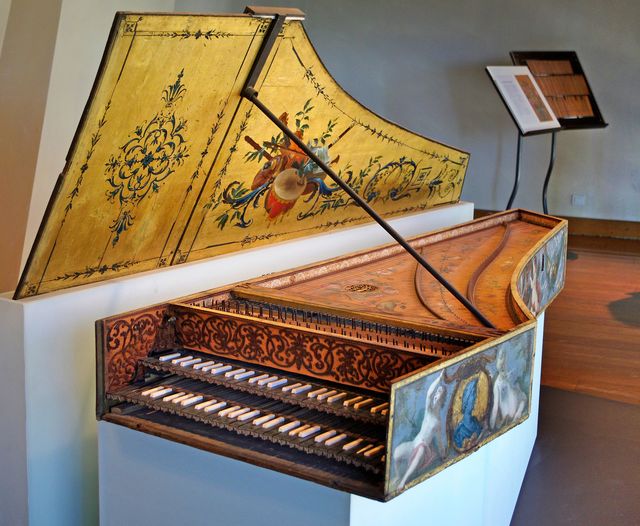Take part with Clavecin en France in the recreation of an exceptional instrument : Jean Denis II, 1648.
FINANCING A MUSICAL AND EDUCATIONAL PROJECT BY CROWD FUNDING
In 2019 the supervisory board of Clavecin en France association asked Emile Jobin to build a copy of an exceptional 17th century instrument that is a symbol of Grand Siècle harpsichord building in France. Jobin is acknowledged as one of the world’s foremost harpsichord builders.
Clavecin en France is inaugurating a new policy with this collaboration between a museum, a team of harpsichord builders, and the members of an association, working together to bring about the historical reconstruction of an emblematic French instrument.
Emile Jobin will collaborate with a scientific committee composed of fellow builders and musicologists. When completed, the harpsichord will expand Clavecin en France’s collection of instruments, whose mission is to promote, support, and diffuse the teaching and playing of the harpsichord.
AN ARTISTIC TREASURE PRESERVED IN ISSOUDUN’S SAINT-ROCH MUSEUM
The Hospice Saint-Roch museum in Issoudun (Indre), standing on the former site of the Hôtel-Dieu, hosts a rich collection of paintings, sculptures, and furniture of the 17th and 18th centuries, that includes a double-manual harpsichord built by Jean II Denis in Paris in 1648.
The Denis family was a famous dynasty of harpsichord builders and musicians (organists and harpsichordists), spanning two centuries (17th and 18th c.). Jean II Denis (1600-1672) was the titular organist of Saint-Barthélemy church in Paris.
He built spinets and harpsichords, and published a Traité de l’accord de l’espinette that was far more than a simple treatise on tuning the spinet, also touching on musical theory, the position of the player at the keyboard, and the composition of fugues. Denis exchanged with Marin Mersenne, and both his daughters had a famous musician as godfather (Pierre Richard and Michel de la Guerre).

© Photo Daniel Jolivet
A UNICUM IN THE HISTORY OF 17TH C. FRENCH HARPSICHORD BUILDING
The Issoudun instrument is unique. It is one of only 33 surviving French harpsichords of the 17th century, a scarcity due to the fact that most musicians played spinets in the first half the century. The Issoudun instrument is the earliest signed and dated harpsichord in a French collection.
It originally had two keyboards with a range of 4 octaves and a fourth (G to c5, short octave), and probably had dogleg jacks for the upper keyboard. There are two 8 foot registers, and one 4 foot register, following the disposition that would become traditional in France. The keyboards were later enlarged to follow the evolution of musical writing, with two extra keys in the treble (c5# and d5), while in the bass the short octave was replaced by a chromatic octave without G#. There are three different numbering systems for the keys, corresponding to these modifications.
A SUPERB PIECE OF FURNITURE
© Photo Jean Bernard - Musée de l’Hospice Saint-Roch
The soundboard retains its original a tempera decoration with magnificent flowers, birds, and insects, following the tradition of the Antwerp workshops. Hand-printed papers decorate the edges. The lead rosette represents a female lutenist sitting under a canopy, surrounded by grotesque ornaments.
SCIENTIFIC INVESTIGATIONS, EXPERIMENTAL AND MUSICAL RESEARCH, USE FOR PEDAGOGY
After its identification by Michel Robin in 1986 and its classification as a historical monument in 1987, the instrument was the object of an organological study (1989-1991) and a plan (2002) by Alain and Marie-Christine Anselm. Clavecin en France has chosen to reproduce the instrument in its original state (1648), hoping to bring back to life the lost sonorities of the mid-17th century.

The possibilities the instrument will offer for playing polyphony (petit chœur - grand chœur), its volubile keyboard, and different registers, should lead to new musical discoveries, and allow for a renewed exploration of the works written for this type of instrument, those of the first French harpsichord school : Jacques Champion de Chambonnières, Louis Couperin, Johann Jakob Froberger, Thomelin, Richard, etc.)
Financing a musical and educational project by crowdfunding !
We need 45 000 euros to fund this project.
Whether you are a musician, an amateur, a private individual, or a foundation, you can support us.
Every donation, either modest or large will be welcome. Small streams make big rivers !
Thank you for your support !!



